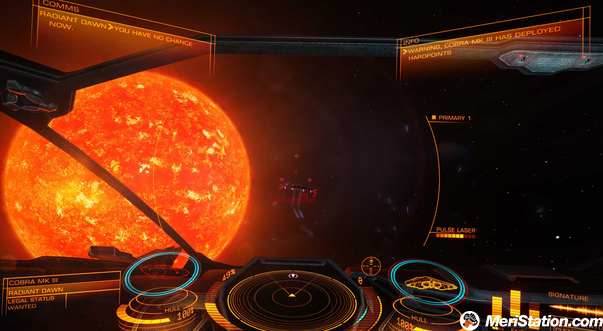In 1984, a radically new concept for 8-bit computers was born for BBC Micro: Elite. A game of simulation, combat and space trading in an immense space that seemed impossible to contain in 52 kb. 8 Galaxies, 256 planets and the player, a tiny dot in the middle of the immensity, with nothing more than a small ship called Cobra and 100 miserable credits.
The objective? the one you marked yourself. Technically you could aim to become the highest ranking pilot, performing risky missions for the different galaxies, but you could also become an interspace merchant, or a pirate who achieved his fortune through pillage.
The money allowed us to equip ourselves with better ships and better equipment, although with the idea that this investment could be lost if we were destroyed. It was not the first game that focused on the idea of commerce and space travel,
The feeling of freedom to control your destiny in a procedural sea of stars laid the foundations of a game with a huge influence on the development of space games. The same Elite was developed in two sequels and the genre sought new and ambitious borders -with better and worse results-, until one day it was frozen in time and the companies decided that they were no longer interested.
Fortunately, the wave of crowdfunding had as one of its great effects the return of this kind of games, with fans taking out their wallets to bring back a game class that dominated the entertainment hours of millions of players in their day.
Two of the direct consequences of that movement are precisely Star Citizien, from the creator of Wing Commander, and Elite, which after so many years since the release of the third part has finally been able to continue the saga under the name of Elite Dangerous.
The starting point remains the same: a nobody in the middle of the vastness of the Milky Way with all the possibilities open to make a fortune. Of course, the space is not the same as the one that could be offered in 52 kb – even though it was procedural – now the study has allowed us to recreate our galaxy in a scientifically approximate way, which is a colossal space of
400,000 million solar systems completely explorable, all with planets with credible chemical compositions, adequate orbits and stars of different types crowning the different systems. Although humanity has expanded across the galaxy and there are three major factions occupying a
large portion of systems, these occupy only a tiny part of the map, which is surrounded by what is known as “deep space”, in large part unexplored. Seeing the map of the game is an amazing exercise when you realize the immensity of which we are surrounded as the zoom goes further and further to understand that the size of the title is not misleading advertising.
There is no fixed pattern by which you have to dedicate yourself to one thing or another, that depends on your objectives and depending on them you will earn money and improving your ship
and equipment to adopt the role you deem most appropriate. Each inhabited solar system can have one or several space stationswhere you can land and, depending on the type of station and its facilities, can do things like refuel, repair, buy equipment for the ship, see the latest news –
which have real implications in the economy and how the fabric is formed geopolitical of the galaxy- and accept missions of different types to get easy credits, in addition to being able to buy new ships if it is a station of a certain size. Once you start to accumulate some credits it will be time to buy a ship better than the initial and in doing so you will have to take into account the different activities that you can undertake.
For example, there are ships that are specially designed to transport. In its most basic model, a Hauler, we would find a kind of space “truck” with few options of defense, low maneuverability and little space for joys in terms of equipment, but capable of moving more tons to expand our profit margins and start to get performance when buying cheap and selling expensive.
It must be said that the game does not offer you all the tools to know if a route is going to be profitable or not. We can only see the supply and demand of a certain product in our station, as well as see the average price in the sector, so that if a product has a high offer, we can assume that it is at a good price. But to place it at the best profit margin we can not know the sale price in a destination station,
we must go and see if the trip has been worth it or we try better luck elsewhere. However, there are a number of clues that we can assume, since each station is of one type – tourism, mining, industrial, high technology and several others – so supply and demand is determined in part by its activity.

